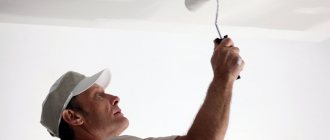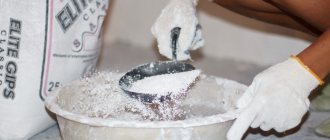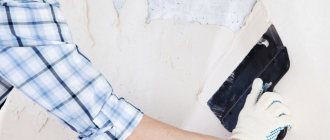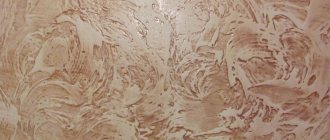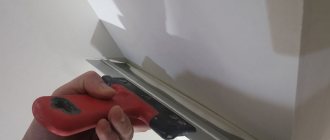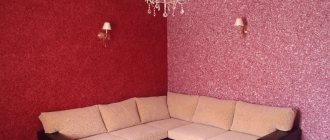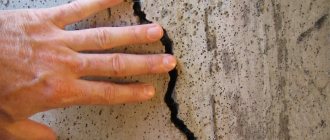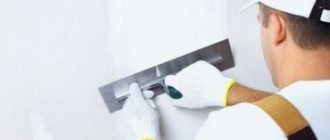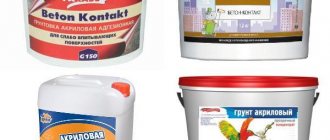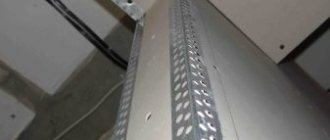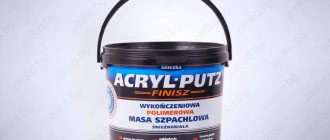Liquid putty is available in a ready-to-use form, which is of course very convenient. This solution has the consistency of thick sour cream; its use guarantees an excellent result, which dry materials cannot always provide.
The price of such a product is, of course, much higher than dry mixtures, but this largely compensates for the cost of effort and time when performing repair work. Another advantage of liquid putty for walls is a fairly long shelf life when opened, during which the putty does not lose its properties.
Purpose and application
Liquid putty is intended for applying the finishing layer of the mixture when treating walls on an already prepared base using primer solutions. Depending on the type of coating being processed, individual compositions are used; we will talk about the types of putties in the next paragraph.
Wall finishing with a liquid putty solution is used for the following types of base:
- tree;
- plastic;
- drywall;
- metal;
- polyester;
- aluminum;
- plastered walls.
Note! When performing repair work, it is necessary to select a liquid solution for a specific base and determine the type of treatment that will be carried out.
What is liquid putty
There are two types of putties on the building materials market - wet and dry. The cost of dry mixtures is lower, but at the same time the cost of effort and time for preparing the solution increases. To avoid difficulty in carrying out repairs, you can use wet putty. Liquid putty, the price of which is higher, is sold in plastic buckets and resembles the consistency of sour cream, so it is easy to work with.
Universal putty Danogips SuperFinish 28kg
Pre-mixed, ready-to-use SHEETROCK® All-Purpose Putty contains vinyl binders and other ingredients that make it perform better than other conventional pre-mixed products. Mixed to a creamy, uniform consistency and containing vinyl fibers, United States Gypsum Company putties have excellent smoothability, surface adhesion and are easy to work with. SHEETROCK® (Sheetrock Price) can be used straight from the bucket and requires only minimal stirring and dilution. When working with ready-to-use putties, sealing the joint is quick, easy and simple, which reduces labor costs, improves the appearance and quality of work. Instructions for use of SHEETROCK® (Shitrock): • For applying connecting tapes • For the first layer on metal corners • For 2 and 3 layers (finishing) • For the finishing layer • For lamination • For texturing • For sealing cracks inside plaster or masonry without moisture • For work on plaster and concrete base Information about SHEETROCK® putty (Shitrok): Material: Putty with vinyl-based binders. Application: Manual or mechanical application. Sensitivity to freezing: Protect from freezing. When freezing, do not accelerate thawing using heating devices. Thaw at room temperature. SHEETROCK® Consumption: Approximately 67.4 kg. per 100 m2 of plasterboard sheet surface. Shelf life: Up to 9 months under good storage conditions, store the composition in a protected place, since high temperature or cold causes accelerated aging of the putty. Check release dates periodically. Allocate buckets with the earliest release dates for work. Packaging: Plastic bucket with a capacity or weight of 946 ml., 5.4 kg. and 20kg. respectively. Drying time: Within one night (depending on air temperature and humidity) Temperature: Minimum 13 degrees Celsius (inside the building when sealing joints) Color: White Density: 1.65kg/l ..
RUB 1,200.00
Ready putty Rotband Pasta \Rotband Pasta 20kg
Ready-made putty mixture based on a polymer dispersion with mineral limestone filler and additives that regulate the properties of the mixture. Ideal for thin-layer puttying of surfaces. Thanks to its high plasticity, it is easily leveled and perfectly fills all small irregularities. After drying, the surface is ready for finishing with paint or wallpaper. Consumption: when sealing KNAUF sheets with thinned edges: 0.3 kg/m with continuous putty: 1.7 kg/m2 Density: 1.7 kg/l Used for: puttying plaster and concrete surfaces of walls and ceilings before wallpapering or coloring; sealing joints between Knauf sheets with a thinned edge (UK) and a straight cut edge, in combination with reinforcing tape; finishing puttying of the surface and joints of KNAUF sheets sealed using a mixture of KNAUF-Fugen or KNAUF-Uniflot, when preparing the surface for high-quality painting; KNAUF-Rotband Putty Paste cannot be used to seal joints between perforated plasterboard sound-absorbing sheets. ..
820.00 rub.
Buy liquid putty
Composition and technical characteristics
Liquid putty is a substance that has a creamy consistency. It contains various chemical additives that help create a perfectly smooth coating and significantly improve the properties of the treated base. It will not be possible to knead such a product yourself, since the technology for manufacturing the substance requires the use of special factory equipment.
When choosing a putty, you need to pay attention to the following technical parameters, which are indicated on the packaging:
- material consumption;
- drying time;
- minimum layer thickness;
- maximum layer thickness;
- permissible temperature for use.
As an example, consider the technical parameters of Bergauf liquid acrylic putty (manufacturer: Germany):
- material consumption per square meter – 1 kilogram;
- maximum layer thickness – 1 millimeter;
- minimum layer thickness – 0.1 millimeter;
- drying speed – 4 hours;
- permissible temperature of use is 5 to 28 degrees.
Consumption per 1 m2
The consumption of putty depends entirely on the type of liquid solution used and the type of base being treated. On average it is 800 grams per square meter.
Features of using liquid putty
Liquid putty is a new word in construction. It is sold ready-to-use. Thanks to its unique properties, this putty ideally levels the surface, preparing it for applying the top layer - painting or wallpapering. Liquid putty fills all microcracks and smoothes out surface defects, forming a protective film layer on the latter. Deep defects are pre-treated with regular or coarse-grained putty, mounting foam or sealant, and after that the surface is covered with finishing (fine-grained) putty.
Peculiarities
Liquid putty differs from other types of putty by its good spreading over the base that is being processed. This composition can be used to eliminate any kind of defects. Another feature of the putty is its good convergence; it creates a perfectly even coating without mechanical impact. This putty sets quickly, does not shrink, has high strength and resistance to external irritants. Also, the consumption of putty in liquid form is significantly less than that of other compositions.
Features of the composition
The most commonly used putty is a two-component putty, which is suitable for processing parts made of various materials. It contains polyesters or acrylic resins, as well as various fillers, which give it strength and promote rapid drying.
When using a two-component putty, it is important to remember that it comes with an activator, which is added in an amount of 3-7% of the base weight for faster hardening of the material. An excess or lack of activator affects the polymerization process and significantly reduces the quality of the applied base.
The mixture is applied quickly (no more than half an hour), as it dries in a very short time. It is important to remember that polyester mixtures shrink less than epoxy mixtures, and the latter are also much less amenable to sanding.
Kinds
The following types of liquid solutions are distinguished:
- Acrylic. This composition can be used for both façade and interior work. Acrylic putty perfectly eliminates significant defects on drywall and concrete bases. The liquid solution dries quite quickly, in 5-7 hours. The drying speed depends on the density of the base being treated.
- Latex. Such mixtures are intended for finishing and eliminating small defects on drywall. For such purposes, the product must be sprayed into a thin ball, since it has a fine-grained structure. Latex compounds are excellent for processing niches and arch openings.
- Facade. This material is highly resistant to moisture and temperature changes, so it is used for facade work. The composition contains antiseptic agents that provide the coating with proper protection against mold and fungal infections. Due to its composition, the product can also be used to treat walls in rooms with high humidity, including baths and saunas.
Note! In order to ultimately get a high-quality result, it will be enough to use a little mixture to complete the finishing layer. In this case, it is not necessary to use additional mechanical force to level the base.
Basic rules of application
To obtain maximum effect, it is important to adhere to certain recommendations when applying it to workpieces.
Liquid putty for cars: how to use
First of all, the temperature indicators must correspond to those indicated by the manufacturer on the packaging. It is also advisable to use putty, paint and primer from the same manufacturer - they are guaranteed to fit together and ensure maximum adhesion of the components.
The composition is applied in 2-3 layers, with the total coating thickness being 300-400 microns. Experts advise applying liquid putty over the entire area of the part, and not in separate areas, since the transition points will be visually noticeable. The diameter of the nozzle used for application should be no more than 2-2.5 mm.
It is strictly not recommended to add any solvents not intended for it to the composition. This may adversely affect the quality of the coating.
In addition, liquid putty does not tolerate moisture, so the room where the car is processed and dried must be dry, and water should not be used during the processing process itself. As with other varieties, liquid requires the application of a filler primer.
Mode of application
Let's look at step-by-step instructions for using liquid putty for treating walls:
- The first stage of the work is preparing the foundation. To do this, it is necessary to remove dirt, dust, and oil stains from the surface. Then the wall should be vacuumed and wiped with a damp cloth.
- After the wall is completely dry, it is necessary to prime it well. For these purposes, a universal type acrylic primer is used. Apply it with a roller to the entire surface of the wall. After the first layer has completely dried, you need to apply the primer over the entire surface again.
- Next, we move directly to the filling process itself. For these purposes, a wide and narrow spatula is used. The mixture is scooped up with a narrow tool, and putty work is carried out with a wide spatula. The tool should be held at an angle of thirty degrees, and processing should be performed with smooth movements with even pressure. The result of this manipulation is a perfectly smooth coating.
- After the liquid putty has dried, the coating should be sanded. In this case, sandpaper or an abrasive mesh is used. All irregularities are smoothed over with the selected material. You should work in bright light. After sanding, if necessary, repeat the puttying procedure again.
Note! To eliminate defects on concrete bases, it is better to use a liquid aluminum solution, which perfectly fills even narrow cracks and, after complete drying, forms a fairly durable and hard coating.
Benefits of use
Liquid putty is applied to the part using a spray gun and dried with ultraviolet light. The final stage is sanding. To do this, use fine-grain sandpaper. The use of liquid putty allows you to:
- hide even clearly visible dents, cracks and paint chips;
- filling microcracks and pores, preventing corrosion processes;
- protect against peeling of the paint layer applied on top, ensuring a long-lasting effect from the repair performed.
In many ways, the result of painting a car depends on the degree of adhesion of the mixture. Liquid putty is characterized by a high degree of adhesion to various types of surfaces (aluminum, steel, plastics).
Advantages and disadvantages
Like all other building materials, liquid putty has its advantages and disadvantages. Let's look at them in more detail.
Advantages of the composition:
- high elasticity – ensures ease of use of the product;
- resistance to temperature changes and moisture - allows you to use the solution in rooms with high humidity and perform facade work;
- the ability to apply the material in a thin layer - this quality makes it possible to apply the putty in a layer of less than one millimeter and thus eliminate all minor flaws on the base;
- high level of adhesion to finishing - this coating fits perfectly on various starting putties and plasters, as well as on drywall and wood;
- no shrinkage - if you use the mixture according to the instructions, it will not shrink during the finishing process;
- the possibility of using a sprayer - to treat some surfaces such as drywall, the product must be sprayed over the base for a better result;
- durability - such a coating can last for several decades;
- drying speed - this material, compared to other mixtures, dries completely within a few hours.
Disadvantages of the solution:
- high cost - such compositions are much more expensive than dry mixtures;
- limited layer thickness - the material is designed to create a smooth coating, and not to eliminate large flaws in the base;
- zero vapor permeability - liquid putty does not allow air to pass through, so after its application the walls stop breathing.
Technology and benefits
The structure of the putty's liquid consistency is similar to paints and varnishes that promote self-leveling.
Production technology allows:
- spread evenly, forming a perfectly flat surface;
- fill all irregularities and small cracks.
It is presented by different manufacturers, the components included in its composition may differ, but it is usually created on the basis of polyester resins.
Advantages of liquid putty:
- plastic coating for the wall, leveling the last layer more evenly than the previous ones;
- eliminates minor roughness, which is especially important before decorative painting of walls;
- creates a quality finish, on which the quality of decorative finishing processed on top and based on it depends.
It is sold ready-made in construction and finishing materials stores in a plastic container, and after opening it is stored for 2 to 4 months if the container is tightly closed and air does not penetrate inside.
Tool selection
You can treat walls with a liquid solution yourself or with the help of a team that uses a special sprayer.
When finishing putty yourself, a roller is used. This tool must be selected correctly relative to the surface being processed.
When applying putty you should:
- read the instruction manual for the material;
- prepare the basis for the work;
- use a roller to complete the work.
If there are roughness on the surface to be treated, putty should be applied in several layers. Each layer should not exceed 1-2 millimeters and is applied after the previous ball has completely dried.
Also, when performing finishing work using liquid putty, you can use a spatula. Detailed instructions for using this tool are described above.
If repair work is carried out by specialists, they use a sprayer for these purposes. The material is applied evenly, in a layer of one mm. This method provides the coating with durability and elasticity.
Application options
You can apply the finishing primer when filling a wall either yourself using a roller, or by hiring a repair team to distribute it on the surface using a special sprayer.
The putty does not shrink if the conditions of its use are strictly followed.
This mixture is applied with a layer thickness of no more than 1-2 mm, and in some places less than 1 mm is sufficient on the starting layers of any type of plaster or other types of putty mixtures.
Roller application
Before applying the liquid mass yourself, you need to choose the right type for the type and material of the wall.
When applying putty you must:
- read and follow the instructions for use;
- clean surfaces from dust;
- Use a roller for application.
To apply the liquid mass evenly with your own hands, you must use a roller.
However, you cannot putty the corners with a roller, and the applied layer will be too thin, so if there are rough spots, 2 or 3 of them will be needed after the previous one has dried.
Other application methods
When applied by spray, the layer is thinner, and even with a layer thickness of less than 1 mm, due to its elasticity, the dried mixture does not crack and lasts 10 years without loss of properties.
When choosing the type of composition, you should consult with the seller regarding the size of the spray nozzle.
Tips and recommendations for use
When working with liquid solution, you must adhere to the following recommendations:
- Before applying the putty, any substrate to be treated should be cleaned of debris, dust and wiped with a damp cloth.
- In order to eliminate remaining dust after cleaning and increase the adhesion of the coating, it should be primed with a special solution.
- Before and after applying the last finishing ball, the base should be treated with sandpaper or cleaned with a special grater.
- The thickness of each layer of liquid putty should not exceed two millimeters. Otherwise, the risk of cracking of the coating increases.
- When processing the base for painting, it is necessary to lay fiberglass or fiberglass over the entire surface.
Application stages and rules
To answer the question: “How to use liquid putty?”, experts recommend following the rules and basic steps:
- the surface is degreased and polished for the applied coating;
- applying 1-3 layers of coating. When using a spray bottle, a solvent from the same manufacturer must be added to the putty;
- after 2 hours the surface is ready for use.
If you want additional surface treatment, then read the following article “How to sand putty so that it is smooth as glass.”
Review of popular manufacturers
Today on the construction market there are many different materials for puttying in liquid form. The composition should be selected individually for each base and depending on the type of work performed. Let's consider the most popular brands and their prices, the quality of which has been tested over the years.
- Bergauf pasta - about 250 rubles per five kilograms;
- Kale - on average 650 rubles per five kilograms;
- Sheetrock – 500 rubles, available in plastic buckets with a capacity of 5.6 kg;
- Paradise - two and a half thousand rubles per ten kilograms.
The cost of the material may vary depending on the store where the product is purchased.
Liquid putty is a high-quality material for performing the finishing layer of processing. This composition can be used for external and internal work. The material is highly elastic and resistant to external irritants. It also does not shrink, does not crack, has sufficient elasticity and high adhesion. Such a substance will become an indispensable assistant to any repairman for finishing work.
Manufacturers
On the market you can buy putty for your car from the following manufacturers:
- Carfit . This two-component composition is used on passenger cars and other types of cars. Creates a non-porous surface when drying quickly. Apply a layer of up to 35 microns. Cannot be applied over epoxy primer. Mixes with hardener in a ratio of 3.5:100 and dries up to 5 hours;
Liquid putty CARFit Spray
- A80 with Roberlo activator . It has a good ability to fill microcracks and finish the body to a perfectly smooth state. It is characterized by the absence of spreading and is often used when applied to welding seams. This material must be processed with a filler that is appropriate in technology;
A-80 Liquid putty with catalyst Roberlo, 1 l
- 791R . A two-component composition based on peroxide resins is intended for finishing the surface. A peroxide hardener is included in the kit. It grinds well and is applied to steel, creating a film with a high thickness and a uniform structure. It is not recommended to use putty on the surface of a car where a one-component or etching primer has been applied. It is also not recommended to apply thermoplastic paints or primers on top of such a base;
Spray putty (liquid) DuPont 799R + 791R
- Novol . It is applied using a spray gun to fill all sorts of imperfections in the car. Serves as an excellent insulator for metal, preventing moisture penetration. Diluted with 6 or 7% hardener. Applicable to metal and plastic and easy to sand;
NOVOL Spray putty (liquid) 1.2 kg + hardener
- Sprint . This liquid putty for metal based on polyesters quickly undergoes the polymerization process even when applied in thick layers. Helps fill large and microscopic pores, leveling hard-to-reach car surfaces. Another advantage of the mixture is thixotropy (no spreading when applied to vertical surfaces). High elasticity allows for easy sanding. It is recommended to use this mixture when filling a large surface;
Liquid putty Sprint 2K HS Spray
- Chamaleon . It has good filler properties, elasticity, and less weight compared to conventional putty. Dries up to 5 hours naturally and up to 1 hour at 60 degrees.
CHAMALEON 407 liquid putty for cars
Author: Baranov Vitaly Petrovich
Education: secondary specialized. Specialty: car mechanic. Professional diagnostics, repair, maintenance of passenger cars of foreign production 2000-2015. Extensive experience working with Japanese and German cars.
Applying the final leveling coating
The putty at the final stage is applied no earlier than 24 hours after the previous layer was applied. Before starting application, you should check whether what was done the day before has completely dried. If the mixture is dry, it should be prepared in strict compliance with the manufacturer’s instructions, and for greater homogeneity, it should also be thoroughly beaten with a mixer. The advantages of the liquid ready-made composition lie precisely in the absence of this labor-intensive process. The finishing liquid putty can be applied immediately as soon as the package is opened.
There are no special secrets in how to apply the finishing putty, the main application movements are presented in the diagram, and the main secret is that it is applied in the thinnest possible layer of no more than 3 mm. Compositions that are homogeneous with lumps or incorrectly prepared are unlikely to achieve the desired result. For those who have a vague idea, corresponding videos are attached.
Only after basic and primer leveling is finishing putty needed. Otherwise, all the work done will not give the expected result.
Experts have somewhat different opinions on how to properly apply putty. Some believe that for this you need to use the technique of applying short strokes in one layer, and on top of this you need to create the main, leveling, thinnest possible rim. Others, telling how to putty walls, show a technique with 2 spatulas: large and small, which are used in different directions, rolling out the unevenness that the putty texture has acquired in both directions.
To level out significant unevenness, you should work with a large spatula.
The layer of material turns out perfectly smooth if the direction of movement does not coincide with the previous one, but is carried out several times in each direction in one direction and the other.
Features of the material
Liquid putty is intended for finishing coating when finishing walls on a primed base or for preparing surfaces before gluing wallpaper or painting. Can be stored for 2-3 months after opening the container if the necessary conditions are met.
Designed for surfaces made of the following materials:
- wood;
- drywall;
- plastic;
- metal;
- plastered panels;
- polyester.
Basic properties
Liquid putty for walls has a creamy consistency.
Different types of liquid putty differ in drying time, minimum and maximum layer thickness, application temperature, and consumption per 1 m². The data is indicated on the original packaging. The material is moisture resistant and can be used in finishing bathrooms, kitchens and other rooms with high air humidity, providing waterproofing of the wall surface and preventing the formation of fungus and mold.
Has good adhesion to different types of surfaces.
Characteristics
The composition is well distributed over the base and can be used to correct surface defects
Drying time
Liquid putty for walls dries quickly - within 4-7 hours (depending on the thickness of the putty coating and the room temperature). Air humidity for quick drying should be about 50%.
Making homemade putties
A good putty composition should have the following characteristics:
- strength of the formed coating;
- quick drying (no more than 7-8 hours);
- good adhesion;
- plasticity (simplifies working with the material);
- the coating should not crumble;
- absence of harmful toxic fumes;
- smooth texture of the hardened coating;
- resistance to humidity and temperature changes;
- ease of use;
- affordability and the ability to find all components for free sale.
Wood putties
There are several options for homemade putty for wood processing:
- Based on PVA glue with chalk. The substances are mixed with each other until a creamy consistency is obtained. If the surface is too uneven, add wood dust and fine sawdust to the mixture. The main disadvantage of PVA and chalk putty is the long drying time. You will have to wait at least a day for the surface to set.
- Chalk with nitro varnish. Chalk and small sawdust are mixed with the main component - nitro varnish. If desired, you can create a colored composition by adding gouache or a building pigment of the appropriate color. In addition to the coloring matter, you need to add a little solvent No. 647. The main positive characteristic of nitro varnish is the quick drying of the surface. However, there is a significant drawback - the composition is toxic and has a strong unpleasant odor.
- Chalk with acrylic varnish. Water-dispersed paint and varnish material is mixed with chalk. Moreover, there is no need for expensive varnish; any inexpensive composition will do. The components are mixed to a paste. If necessary, add water to make the paste less thick. The color of the composition is changed by adding a color for acrylic paints. The main features of acrylic materials are elasticity and resistance to moisture. If the surface has deep crevices, it is recommended to add fine sawdust to the mixture. The composition dries within 2-6 hours. Specific dates depend on air temperature.
Advice! It is recommended to produce all types of putties in small quantities. Otherwise, damage to the composition cannot be avoided, since it dries out quickly.
The solution is applied to wooden surfaces using a flexible rubber spatula. The coating is sanded using sandpaper on a block or a grinder.
Putties for painting, wallpaper, concrete and plaster
For treating concrete and plastered walls, gypsum-based putties are most often offered. This is not the best material as it dries out too quickly. As a result, you have to prepare the putty in too small portions. In this regard, it is more correct to use a homemade composition:
- Putty on carpentry or wallpaper glue. Components: chalk - 10 kg, 15% glue - 1 kg, turpentine, laundry soap and drying oil - 25 g each. All of the above is stirred to a paste.
- Acrylic putty. You will need the following elements: chalk - 10 kg, acrylic primer - 10 l, 10% wood glue - 2 l. Mix the mixture until you get a paste.
- Casein paint putty. Ingredients: casein paint - 10 kg, water - 7 l. The mixture is diluted with water. Then the liquid composition is heated to 60 degrees. The hot solution is filtered through a sieve. Add 300 g of drying oil to it. The last component to be added is 23 kg of wet chalk.
- Putty based on casein glue. Instead of paint, glue is used, and instead of 300 g of drying oil, only 30 is added. Otherwise, the components and preparation procedure are the same.
